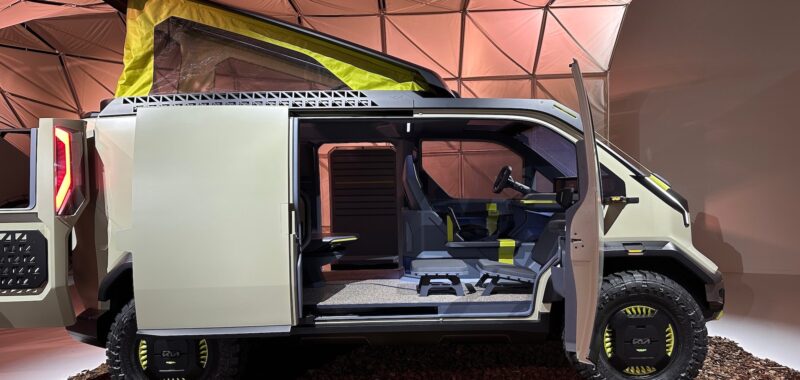Designing concept cars seems kind of like being back in grade school, when kids are encouraged to dream up things like a bedroom with a bouncy-house floor or a spaceship with an ice cream machine on board. At least concept cars have a chance of making it to production at some point, even if that timeline is a long way off.
At Kia’s EV Day in Barcelona, Spain in March, the brand unveiled a new modular electric van it’s calling the Platform Beyond Vehicle (PBV). The PV5 is the first in the automaker’s plan, with four variants: Cargo, Passenger, Crew, and a Wheelchair Access Vehicle option. The designers pushed that a little further with the PV5 WKNDR concept, an EV made for camping and overlanding. It’s not as tall as a Mercedes-Benz Sprinter van so it doesn’t exceed 8 feet, and it’s a bit shorter than a Ford F-150 pickup.
The WKNDR is a radical look into the future of what’s possible, and Kia came up with a few interesting innovations. That includes a spinning turbine-style wheel intended to capture energy from wind and water, solar panels on the roof, and a rail system inside to carry gear efficiently.

Peering into the future at the intersection of art and science
During Design Week in Milan, Italy, the Kia team put its intentions of creating art, engineering, science, and technology on display, including the EV2 concept and the PV5 and a wild, out-there display of high art. Kia has invested a tidy sum into thought-provoking exhibits during Design Week for the last three years, each completely different. This year, A.A. Murakami’s The Cave creation uses robotic limbs, and instruments crafted from replicas of ancient animal bones. Right next to The Cave, Murakami built Beyond the Horizon, arranging mechanical devices to create giant bubbles in random patterns.
“The unpredictable nature of the bubbles – sometimes random, sometimes synchronized – introduces an element of chance, embracing the inherent risk in working with dynamic, uncontrolled systems,” Kia says.
Why spend money on a temporary art exhibit? For the automaker, Design Week represents a chance to encourage its designers as well as the public to think about Kia way outside the box. Kia’s Head of Future Design Andre Franco Luis is tasked with scanning the road ahead and figuring out what drivers want. The creative process of dreaming up concept cars is an automotive designer’s happy place, and people like him get to dabble in creative risk-taking not unlike building an abstract art exhibit. For the WKNDR, Franco Luis challenged his team in California to not just brainstorm but to go out and explore.
“I said to my young designers, I don’t want your research based just solely on the internet,” he says. “We basically have the desert in our backyard; go out there.”
The idea for the WKNDER was pitched at the end of 2023. Obviously, Franco Luis points out, building a car like this is not free. So he and the team presented the concept with a budget outline to convince the management team over a period of about three months. The first sketch was outlined in March of 2024, and the machine was finalized at the end of October.
This “Swiss Army Knife on wheels,” as Kia calls it, is basically a modular living room. The seats move and turn into lounge seats or tables, rails extend across the interior panels for gear, and a rooftop tent includes solar panels.




Can it work?
It’s anyone’s guess whether this monster 4×4 has the potential to make it all the way to production. There’s a chance, Franco Luis says, because Kia received overwhelmingly positive feedback about the WKNDR. The automaker debuted it at the annual SEMA show, which has arguably the toughest and most demanding audience in the industry.
“The SEMA crowd knows what they’re doing,” the Kia futurist says. “If we hadn’t done it right, they would have spotted it quickly.”
Franco Luis asked an engineer to design new control arms for the suspension so if SEMA attendees were to inspect the concept from underneath they wouldn’t be thinking, “Well, this is too flimsy for the size of the tire.” Kia picked Toyo and Nitto tires for the rig because that’s what many serious overlanders use in America, and the team wanted it to be clear they had done their homework. Those tires are no joke: the WKNDR rides on 35-inch Toyo tires wrapped around 18-inch wheels. And the wheels are a whole other animal, ratcheting up the level of innovation exponentially.
Franco Luis camps often, and he noticed he would often run into gusty winds between his office in Irvine and his favorite outdoors spot in Palm Springs. The winds can be an annoyance, especially when setting up camp. He took that observation back to his team and they decided to turn the hindrance into energy using turbine power. Their first idea was to build some kind of contraption on the top but they decided that looked “weird” so they homed in on the tires.
The hydro turbine tires are designed to power the van when moving or stationary. For example, crossing a shallow stream will turn the wheels, creating energy. Wind can move the wheels too, adding power even when parked. This concept is still very much in the experimental phase, so no metrics are currently available for the hydro turbine wheels or the solar array on the roof. For now, that’s not the point. The point is to dream.
“We believe in EVs, and we want to empower our customers wherever they go,” Franco Luis says. “This inspires people to go off the beaten path.”



